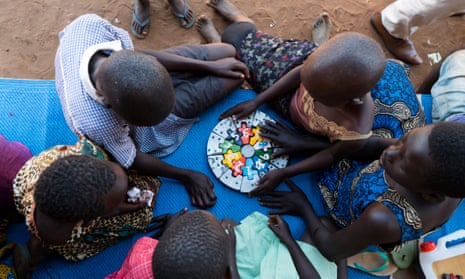More than half of the world’s 7.1 million school-age refugee children are failing to get an education despite recent spikes in enrolment rates, the UN refugee agency has found.
School shortages, oversubscribed classrooms and a lack of teachers in host countries are among the barriers faced by the 3.7 million refugee children aged five to 18 who are currently out of school, according to a UNHCR report published on Friday. The vast majority are missing out on secondary school.
The UN’s special envoy for global education, Gordon Brown, told the Guardian that aid agencies needed to urgently address what he called the “human crisis” in education provision for refugees.
He also called on all donor countries to step up with extra money during next month’s UN general assembly.
The UN’s high commissioner for refugees, Filippo Grandi, said greater investment in education programmes in host countries was necessary for refugees to be able to settle as adults in their current host communities or elsewhere.
“We need to invest in refugee education or pay the price of a generation of children condemned to grow up unable to live independently, find work and be full contributors to their communities,” said Grandi.
Globally, just 63% of refugee children are enrolled in primary school, compared with 91% of non-refugee children, the report says. These figures drop significantly as refugees age: fewer than a quarter (24%) are enrolled in secondary school, compared with 84% of non-refugee children, and only 3% make it to higher education, versus 37% of non-refugees.
The UN aims for all refugee children to achieve the same levels of education as their non-refugee peers in pre-primary, primary and secondary schooling, and to boost refugee enrolment in higher education to 15%, over the next decade.
The report indicates that a number of countries have made significant progress in recent years, from Chad, Ethiopia and Uganda to Iran, Mexico and Pakistan. Giving refugees access to schools, making their timetables more flexible, and offering special help to catch up on missed schoolwork are just a few reasons why refugee school enrolment rates have jumped in the past year. Primary school and higher education enrolment have both increased two percentage points, while secondary school enrolment has gone up by one percentage point from last year, according to the report.
Yet school enrolment is only half the battle for refugee children and staying the course proves extremely hard as they get older.
Half of the world’s 25.9 million refugees are under 18, data shows, yet with so many missing out on education, the consequences on their communities and surrounding areas are likely to be far-reaching, said Justin van Fleet, president of global children’s charity Theirworld. Children in school are less likely to be involved in child labour or criminal activity, the report says, with girls less likely to be coerced into early marriage and pregnancy.
“Investing in education for refugee and displaced children provides hope and opportunity to some of the most disadvantaged children and young people around the world,” said Fleet.
“It is the solution to end the exploitation of girls, protect children from child labour, and create safer and more secure communities.”
In Greece, more than three-quarters of the 4,656 school-aged children on the country’s islands who are asylum seekers and live in reception centres do not attend school. Missing documentation is one of the main barriers, preventing refugee children from being in school for their first year. Lack of funds are the most significant barrier for their second year, the report claims.
“Roughly four out of five refugees are now living in protracted situations, which means that they’re living with the possibility that their entire childhoods could be spent in exile,” said UNHCR’s Matthew Saltmarsh.
“If there is no possibility for them to receive an education or to advance in their education, that will have significant knock-on effects on those individuals and their broader societies. Education ensures that refugees can become more self-reliant and more self-sustaining. To do that, they need to be able to work and live and move around and potentially integrate where they are. Education is absolutely crucial in achieving that.”
Gordon Brown told the Guardian: “When the shocking gaps in refugee education provision mean that just three in 100 young people ever get to college or university, it is urgent that aid agencies act to deal with this human crisis.
“I am calling on all donor countries to fund education in emergencies by committing towards the $1.8bn [£1.4bn] target for the Education Cannot Wait Fund during the UN general assembly in September.”
